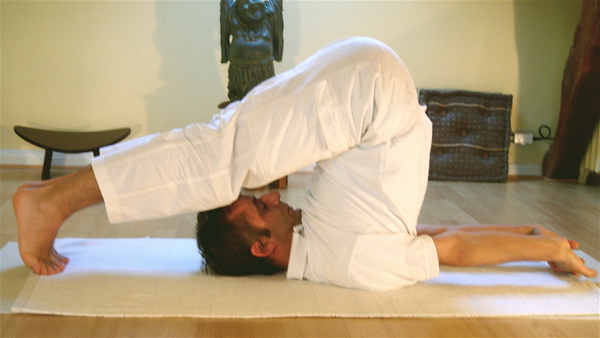Halasana
The name comes from the Sanskrit words hala (हला) meaning "plow" and asana (आसन) meaning "posture" or "seat" .When this pose is practised, it gives the exact appearance of a plough. Hala means a plough in Sanskrit.
Caution: If you have had abnormal blood pressure, glaucoma, detached retina, chronic thyroid disorders, neck or shoulder injuries, consult your teacher and physician before doing the shoulder stand
Procedure
- Go into the shoulder stand. Keep the back supported with your hands.
- Breathe in. Keeping the left leg straight up, exhale and lower the right leg to the floor behind the head.
- Breathing in, lift the right leg straight up.
- Breathing out, lower the left leg to the floor. Keep the right leg up.
- Breathing in, lift the left leg up.
- Breathing out, lower both the legs to the floor. Keep the spine erect. If the feet do not reach the floor, don’t struggle to bring them down. Instead press them toward the wall behind you. Straighten the knees.
- If your toes reach the floor, move them in toward the head and straighten your spine. Press the knees up. Do not press the neck into the floor.
- If you don’t need to support your back with the hands, lower your arms to the floor, palms facing down. Breathe deeply and stay in the posture for 20-60 seconds.
- To come out of the posture, support the back with your hands. Lift the legs up and lower the spine to the floor, vertebra by vertebra, without lifting the head
Benefits
- This Asana tones the spinal nerves, the muscles of the back, the vertebral bones and the sympathetic nervous system that runs along the vertebral column on both sides. This Asana fulfils and amplifies Sarvangasana.
- A large quantity of blood is poured into the spinal roots of nerves, spinal cord, sympathetic ganglia, sympathetic nerves and muscles of the back. Hence, they are all well nourished.
- The vertebral column is rendered very, very soft and elastic.
- This Asana prevents the early ossification of the vertebral bones. Ossification is quick degeneration of bones. Old age manifests quickly on account of early ossification. The bones become hard and brittle in the degenerative process. He who practises Halasana is very nimble, agile, full of energy.
- The muscles of the back are alternatively contracted, relaxed and then pulled and stretched. Hence they draw a good supply of blood by these various movements and are well nourished.
- Various sorts of myalgia (muscular rheumatism), lumbago, sprain and neuralgia are cured by this Asana.
- The vertebral column becomes soft and elastic. It is twisted and rolled as it were like a piece of canvas sheet. A man who practises Halasana can never become lazy.
- The vertebral column is a very important structure. It supports the whole body. It contains the spinal cord, spinal nerve and sympathetic system. In Hatha Yoga the spine is termed as Meru Danda. Therefore you must keep it healthy, strong and elastic by the practice of Halasana. The muscles of the abdomen, the rectal muscles and the muscels of the thigh are also toned and nourished.
- Obesity or corpulence and habitual or chronic constipation, gulma, congestion and enlargement of the liver and spleen are cured by this Asana.

No comments:
Post a Comment